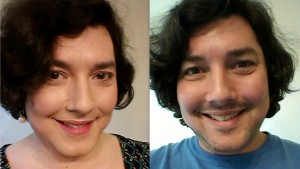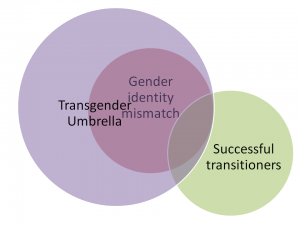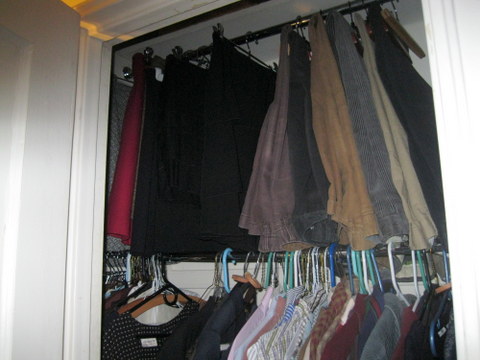I’ve written about how I don’t feel non-binary because I jump from one side of the binary to the other. But that’s not all of it: my masculine gender expression (of the two, the one that’s best developed) is not very binary, and never has been. But I don’t feel like that part is exceptionally non binary. Everyone’s actions are non binary to one degree or another. I’ve just been more comfortable with my non binary actions than a lot of other people.
The reasons we draw lines between men and women are to decide who gets access to what roles and spaces, what we expect from people, and how we’re going to treat them. But no matter where we draw the line between men and women, most people are not going to fit perfectly on one side or the other. I’ve met a lot of people over the years, and when you get to know them, everyone is pretty non-binary.

As I write this I’m wearing all “men’s” clothes and accessories, bought in the Men’s department. I have my fingernails cut short, and I shaved my facial hair using a men’s razor. I’m not wearing makeup. I’m going to my job as a university professor. Tomorrow I will go to my research position in computer science, a continuation of my many years working in information technology. All roles and spaces that have traditionally been “men’s” in middle-class white American society.
I’m doing a lot of things that are unmarked for gender. I’m drinking a latte and riding the subway. I’m writing on a tablet. I’m carrying a backpack. I get together with friends. I go to political meetings. I post on Facebook and Twitter and Tumblr and my blogs.
In my life as a “guy,” I do some things that have traditionally been “women’s work.” Tonight I’m going to meet with my kid’s teachers. Sometimes my wife goes on business trips and I’m taking care of the kid by myself for days on end. When he was a baby I fed him and changed his diapers. I buy almost all of my own clothes. Yesterday I did laundry, for the entire family. On Friday I’ll cook dinner, and probably buy groceries. Tomorrow I might clean the bathroom and go to Weight Watchers. I’ll eat salad. When I was younger I worked as a secretary and ate Special K cereal. I’ve studied yoga and dance. All traditionally women’s roles.
Of course, I’ve known women who wear no makeup, who wear “men’s” clothes, who trim their fingernails and even shave their faces. I have always had plenty of colleagues who were women, in university teaching, in computer science, and in information technology. There are lots of women in university teaching, but in other parts of the country it’s still unusual for a woman to be paid to open up a computer.
I know other guys who take care of their kids, including the feeding and diapers. I was told once that a particular temp agency in another city would not send men on secretarial assignments, but here in New York I met a number of other male secretaries. When I’ve traveled, most of the Weight Watchers meetings I’ve been to have been dominated by women, but here I see men at practically every meeting. Most of the guys I know buy their own clothes, and a lot of them wash the family’s clothes and clean the bathroom and cook dinner. Whenever I studied yoga or dance, there were other guys there. I see guys at Just Salad, and maybe even eating Special K. This means a lot of people crossing traditional gender boundaries.
I do know some people who are pretty damn conventional about gender roles. Women who never wear pants outside the house, men who won’t touch a stove. People who repeat things that sound like they’re straight out of some Victorian etiquette guide. But when I’ve gotten to know these people, there’s always something surprising about them. A woman who started her own business. A man who raised his kids without a woman in the house. Every single one. I’ve never met someone who fit completely within standard gender norms.
Now here’s a problem: essentialist stances on gender rely on binary policing. Whether you say, “all males are men” or “trans women are women,” you’re saying that it matters who’s a man and who’s a woman. Not that it matters for some practical sense, like bathroom access, but that beyond all practicality, it matters to you. Otherwise you’d just say that everyone should be allowed to use the bathroom they choose.
This is a problem because of all the non binary actions I described, all the people who don’t necessarily identify as “non binary” or transgender, but do things that cross gender boundaries. No matter where you place the boundaries, some people will cross it, and some will be straddling it.
Any essentialist approach to gender based on birth assignment will necessarily leave a lot of people unsatisfied. An essentialist, binary approach based on socialization will still erase a lot of people by ignoring the messy gray areas of socialization. An essentialist approach based on professed belief or the observer’s gut feeling (which are the only evidence ever accepted for “gender identity”) ignores and erases my reality, and really, everyone else’s, even if they profess a gender identity, because everyone crosses gender boundaries.
So here are my questions to everyone who believes that there are essential differences between men and women, whether by birth assignment, socialization, professed belief, or your personal judgment: When you divide the world of people into men and women, which roles, spaces and treatments are reserved for one gender or the other, and which are open to all? Does your definition allow my reality? Who would violate your categories? What are the consequences?










